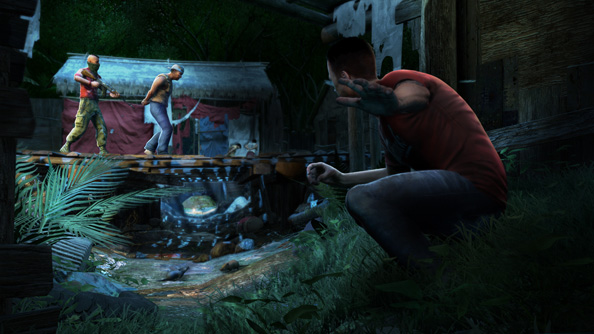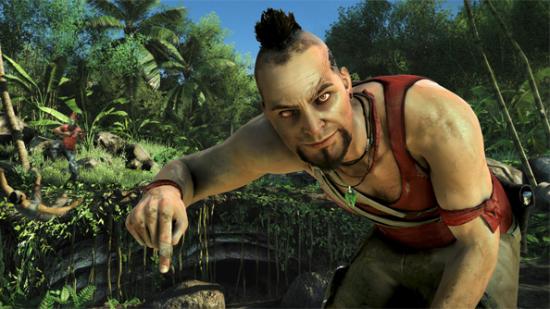Far Cry 3’s got good baddies and bad goodies and a strange bit where you sniff an illegal mushroom and are briefly teleported to a sort of psychedelic subterranean Narnia, which will earn it a special PEGI icon on the box. There’s a lot going on in Ubisoft’s tropical paradise, so we sat down with Jamie Kean, Far Cry 3’s lead game designer, to discuss it all: storytelling, stealth and why they’ve taken loads of ideas from Assassin’s Creed.
PCGamesN: So at the start of Far Cry 3Vaas is an immediately terrifying villain – what work went into creating that degreeof menace?
Jamie Kean:I think it’s really important that you feel his proximity really quickly and that he’s not some notional baddie off in some tower somewhere plotting the destruction of the world. He’s somebody that very quickly is very viscerally in your face. He’s right there, and very scary, and unhinged in a way that… okay, so imagine you’re on the Tube and you see a Tube nutter and think “please god don’t talk to me”. He’s that guy, times ten. And he’s getting right in your face. That’s the feeling that we wanted, that uneasiness of being around somebody who has got apparently so little control over what they might do next, and knowing what they can do when you‘re completely under their control.
PCGN: There’s a clear improvement in the quality of cutscenes since Far Cry 2,What improvements have you made to the engine?
JK: This is the same engine as Far Cry 2, but it’s had a lot of work done on it. It’s a very developed version of the Dunia engine, basically. One of the things with that specifically is the new mo-cap technology that allows us to capture an actor’s entire performance in one go. Before that, you’d do the voice overs first, then do the mo-cap afterwards and try to match the two together. Doing it that waygives it a really stilted feel. This time around we’ve got more definition in terms of what we can capture: we can capture facial and body animations at the same time as the lines are being performed. The high-fidelity of everything we’re capturing allows us to get a real sense of life. And you know, it lets the actors that we work with really do what they’re good at, which is acting. When it feeds into the game it becomes an authentic feeling experience.
The idea of contact is something we try to reinforce across the board too, whether it’s in the core gameplay mechanics or in the very visceral way in which you interact with the world. It’s all about reinforcing that connectedness with the characters so that when you do then come across a character like Vaas it feels so much more immediate. Or when your brother’s been shot and you’re trying to stop the bleeding, you feel connected, you don’t just feel like a camera on a stick walking through it all. It’s something you’re really engaging with.
PCGN: There are a lot of very similar features shared between Assassin’s Creed 3 and Far Cry 3 – was this something you were aware of during development?
JK: I don’t think any of us develop in a bubble or in isolation. I think it’s very true of Montreal as a studio that we’re very lucky to have so many big projects going on that it means we can draw from so many different influences at the same time. And if there are systems that work, and there are solutions to problems that work, then we want to use them. We want to colour them in a way that fits with the world that we’re creating. So things like the radio towers: sure, you’re going to see towers in other games, you’re going to see high points in other games. It’s just a truth about how you navigate around in a world – if you want to get a good overview about something, you get up high and have a look around. We want to make sure we’re colouring it in a way that is congruent with the world as a whole.
It comesback to wanting players to feel a connection with the world, we want players to feel vertigo when they’re climbing those towers, we want them to feel afraid. Especially later on in the game, there are some pretty nasty jumps you have to make and you can die doing it. When players see a rickety bar they have to cross, we want them to have that “oh god” feeling in the pit of their stomach. That’s what we’re looking to create, those emotional and physiological reactions.
PCGN: Stealth is obviously important in Far Cry 3, how do you avoid falling into typical stealth game traps? Is there a mission, for example,where you fail automatically once spotted?
JK: I think there are a couple of missions where that might happen, yeah, definitely. It’s one of those things: we try not to trammel the experience as much as possible, but every now and again we probably will do. It’s part of any gameworld that you’re given objectives and you either fail or complete them. Generally however we try to take the approach that it’s about player choice and that there isn’t a right or a wrong way to do things. That spreads right the way through from how you approach the game world – deciding what to do next, whether to pursue to story or explore- down to whether you’re going to approach a situation using stealth or assault. Sometimes we break it and we play with it a little bit, but generally that’s the approach we want to take.
Often we get the question “well what do I do next?”, to which we can say “go do what you want to do”. That’s hugely liberating for people and really lets players express themselves creatively while they’re playing. It’s gratifying for us too, we want people to feel that sense of freedom when they’re playing the game.
PCGN: The map’s litteredwith constant invites to go do other things, like Path of the Hunter for example, how much of that kind of contentis there?
JK: Hmm, I’m trying to remember the exact number of those we’ve got but… there are a lot of them. They’re also about different kinds of experiences, did you play the Wanted Dead bounty quests?
PCGN: Yeah, the first one, I stabbed a pirate with a knife.
JK: Yeah, that’s right. We have those running through the whole game world. They’re always there to drop into, they’re little playful vignettes of gameplay for you to get involved in. The Wanted Dead quests are about stealth generally and playing with a lot of the stealth systems, whereas the Path of the Hunter missions are about hunting gameplay. We’ll add little artificial restrictions to those but it’s more to vary up the gameplay, to ask the player to play in a way they wouldn’t normally be playing. But again they’re completely optional, it’s up to you.
We have a whole host of narrative side missions as well, which are much more about the feel and the colour of the world, showing what’s happened on the island before you arrived and what it’s like for people now. They can be a bit playful as well. It’s important that we have that variety and breadth of experience in the game.
PCGN: Jason starts off as an unwilling killer.Was it difficult to transition from that narrative version of Jasoninto normal gameplay, in whichthe player is killing mindlessly?
JK: The bit that’s most difficult to justify about it is the discrepancy between Jason as a character – this 25 year old, west coast American guy – versus a player, and quite often a player who’s probably quite good at shooters. Having those two things working together in a waythat doesn’t feel like either is being hamstrung is probably the biggest challenge. We want you to feel like, as Jason, you’ve not done this before. You feel there’s a slight revulsion in Jason’s first kill, you’re looking at your hands and you’re shaking, you feel there’s a real threshold that you’ve crossed there. But as a player, you’ve probably been playing shooters for a while, you’re not Jason, you’re good at moving around in a gameworld and you’re good at shooting. So there’s a tricky balance to strike between feeling like a guy who doesn’t know what he’s doing, versus not being a frustrating experience for somebody who has played games before.
I think we also do that by growing the repertoire of skills you have as a player rather than restricting it. If you’re a shooter player, you’ll feel comfortable in that initial skillset before we give you more stuff to do on top of that. So things like the takedowns, for example, are quite a new style of gameplay for a shooter. You can really expand on those, some of the takedowns go hand in glove with the stealth gameplay. You’ll find yourself sitting in a bush, waiting for the perfect setup to use one of these skills. The idea of you getting better as a player is mirrored by Jason in the world.
The narrative calls you out on that, though. Jason and his friends have all arrived on this island, but Jason goes off and becomes seduced by the island, he gets drawn into the allure of the place, discovers that he’s quite good at killing people and also starts to quite like it as well. That sort of mirrors the process that you go through as a player, where you’ve been dropped in andyou don’t know how the gameworld or its systems works. You start enjoying it, enjoying the exploring and the gameplay as much as Jason does.
And then, when you come back into the storyline, one of Jason’s friends will say “what the hell’s going on man? You’re killing people, you’ve got all these tattoos…” That happens at points throughout the game. It’s really good, it draws you back after you’ve just taken down an outpost. You’ve killed a dozen men, you’ve nailed it, then the game says “what the hell are you doing?” That constant questioning of what you’re up to is really interesting.
PCGN: Thanks for your time.
Far Cry 3 is out November 30 on PC. You can read our hands on preview right here.
